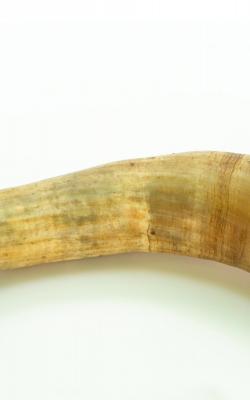Until we had a massive spread of metal and synthetic mass-produced products, in the traditional folk inventory of utensils, a well-defined role - in addition to the wooden, stone, iron or clay objects - was also played by objects made of horn.
As beef horn was available to all plowmen and herdsmen, the shaping was easier and the applicability more varied, and in what concerned the manufacturing work, it didn’t necessarily require a specialization. Hollow on the inside, the horns are easy to shape, being made of a chitinous substance. The most suitable for making various tools are large, smooth, white-transparent horns, black to the tip, like those of cattle from the ”grey steppe” breed. These tubular horns (especially large ox horns) served as a material for a variety of utensils: blow horns for herdsmen, swineherds, and hunters; horns for decorating the wedding carriage; heels for wrinkles, heels for gunpowder, horns for decorating pots, etc.
In case of the blow horn in the picture, it was used by swineherds. They used to blow them, announcing their presence on the village streets, so that the villagers could take their pigs out of the household, the swineherds taking the animals to the pasture. In the larger villages, there were two swineherds using horns, one coming from one side of the village and the other from the other end.
In the picture, there can be seen a blow horn (used by swineherds), with a length of 25.5 cm. The piece has inventory no. 284 and it entered the museum’s patrimony in 1923, being purchased from Lelese village, Hunedoara county.
Text: Andrei Filip – MET museographer
Photo: George Ciupag – MET museographer, photo-video processing











